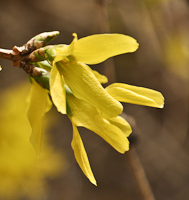 There really is no
"treatment" for plants infected with forsythia gall. Once
the symptom i.e. the gall shows up, it is too late to
treat even if there were pesticides available for the
purpose. So, the main control options rely primarily on
preventing the infection in the first place.
There really is no
"treatment" for plants infected with forsythia gall. Once
the symptom i.e. the gall shows up, it is too late to
treat even if there were pesticides available for the
purpose. So, the main control options rely primarily on
preventing the infection in the first place.
1. Prune Off Infected
Galls - To make the plant look better, you can cut
off and destroy the infected stems below where the gall
has formed. Sterilize the pruning shears with a one part
bleach to nine parts water solution between cuts and
before moving to prune other plants.
2. Destroy Infected Plants - Remove and destroy
(burn or send to the dump) infected plants. Since the
bacterium stays in the soil for years, replace it only
with a plant species known to be resistant.
3. Sterilize the Soil - Commercial nurseries have
potent chemicals known as soil sterilants available to
them but, unfortunately, these are not used in home
landscape situations.
4.
Exclude the Problem - Purchase plants from
reputable nurseries only. If someone wants to give you a
plant, be sure to closely inspect them for any signs of
galls.
5. Plant
Resistant Species - Several landscape plants appear
to have a high degree of resistance to bacterial crown
gall. These would include barberry, hornbeam, true
cedars,
ginkgo, golden raintree, tulip tree, mahonia,
spruce, linden, boxwood,
Catalpa, beech, holly, larch,
Magnolia, black gum, pine, Douglas fir, bald cypress,
hemlock, birch, firethorn, redbud, smoke tree, sweet
gum, deutzia, serviceberry, yellowwood, yew, and zelkova.



